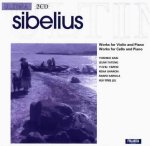Yoshiko Arai and Izumi Tateno find engaging contrasts, both dynamic and tonal, in Sibelius’ E major violin Sonatina, especially in the central Andantino. However, the recording balance favors the piano, so in the vivace coda of the finale, where the violinist is tested by rapid and difficult writing, he is heavily outgunned. The remainder of Disc 1 comprises performances from Yuval Yaron and Rena Sharon. The last of the Op. 78 pieces (“Religioso”) shows how apt Yaron’s densely sonorous tone is for Sibelius’ often weighty ideas (in comparison, Arai is a mere lightweight), but it’s a pity Yaron doesn’t let himself relax more in some of the lighter offerings, such as the Op. 81 set, where his rubato is mannered and a bit self-conscious (the Valse, No. 3), and noticeably stiff in the Mazurka that opens the group. On BIS, Nils-Erik Sparf and Bengt Forsberg display an easy lightness that suits the music well. Nevertheless, Sparf isn’t quite in Yaron’s league as a virtuoso, so you’ll hear some edginess and unevenness of tone in his BIS version of the Humoreske (Op. 115 No. 3–the best-known of Sibelius’ violin miniatures) beside Yaron’s more polished and effortless reading.
Disc 2 replicates the Op. 78 violin/piano pieces in the composer’s cello versions, where they’re played with warm tone and clean articulation by Raimo Sariola and pianist Hui-Ying Lu. Their performance of Malinconia, the longest of Sibelius’ cello pieces, is capably done, although its dynamic and dramatic contrasts are not emphasized enough. A useful alternative is the BIS survey of these pieces by Torleif Thedéen and Folke Gräsbeck, who observe tempo fluctuations more rigorously and bring out the expressive range of the music more convincingly. Still, with Ultima’s package available for less than a single BIS release, this Sibelius double deal is good value for money.
































